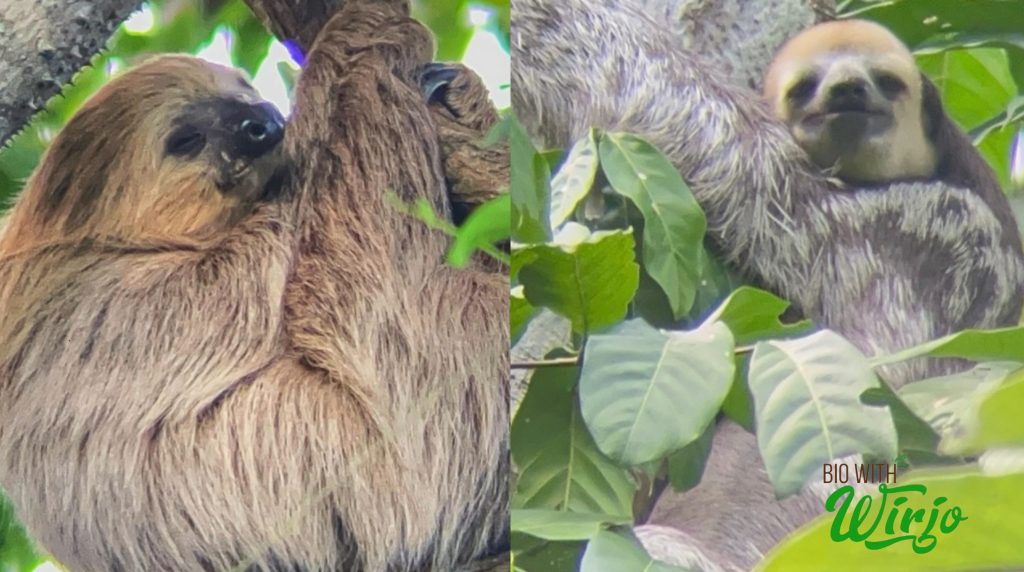1. THERE ARE 2 GROUPS OF SLOTH IN THE WORLD
Different sloth groups can be easily identified by the number of long, curved claws on their forelimbs. The two-toed sloths, as the name suggests, have two claws on their front limbs, while the three-toed sloths have three claws on all four limbs. The two-toed sloths are also slightly larger than their three-toed counterparts, and both fall under different taxonomic Family. Altogether, there are six sloth species that are found in the Americas, mainly in the tropical rainforests of Central and South America.
- Hoffman’s two-toed sloth (Choloepus hoffmanni)
- Linnaeus’s two-toed sloth (Choloepus didactylus)
- Pygmy three-toed sloth (Bradypus pygmaeus)
- Maned three-toed sloth (Bradypus torquatus)
- Brown throated sloth (Bradypus variegatus)
- Pale-throated sloth (Bradypus tridactylus)
At present, 4 sloth species are listed as least concern on the IUCN Red List of threatened species. The maned three-toed sloth is vulnerable, while the pygmy three-toed sloth is critically endangered and the sloth species at greatest risk of extinction.
2. EVERYTHING IS SLUGGISH AND SLOW-MOVING, EVEN FOOD DIGESTION
Sloths are primarily folivores, feeding mostly on leaves, fruits and sap of various trees. They have a large and efficient multi-chambered stomach that helps with digesting tough, fibrous leaves. The sloth’s digestion rate is linked to its low metabolism, and more leaves can only be ingested once there is enough room in the stomach—this is often full accounting as much as 37% of its body mass. Therefore, sloths eat very little food per day since digestion takes a very long time to complete, sometimes even days or weeks.
3. THEY SPEND MOST OF THEIR LIVES HANGING IN THE TREES
All modern day sloths are tree-dwelling, suspensorial mammals, spending most of their lives hanging motionless or slowly moving between tree branches using their long, curved claws. Everything from feeding, sleeping, resting to mating and giving birth happens in the trees. But there are times when even sloths must leave the comfort of their tree canopies and descend to the ground.
4. THEY ARE INCREDIBLY PICKY WHEN IT COMES TO POOPING
Sloths, like all living things, need to defecate, which usually happens once per week. Pooping while hanging upside down might seem like an easier option, but sloths are incredibly fussy when it comes to personal hygiene. In the wild, they are known to make a slow, arduous journey from the tree canopy to the bottom of the same tree in order to defecate or urinate on the forest floor.
5. SLOTHS ARE SURPRISINGLY GOOD AT SWIMMING
Life can be difficult on the ground for sloths since their long clawed arms and shorter, weak hind legs make it impossible to stand on all fours. However, they are surprisingly strong swimmers. Sloth species living near mangroves or rivers sometimes drop into water bodies and swim large distances (in a short amount of time) when searching for potential mating partners or seeking new territory.
6. THEIR SLOW-PACED LIFESTYLE HELPS THEM TO SURVIVE IN THE WILD
It’s true, sloths are incredibly slow-moving mammals, often hanging motionless on branches between feeding and sleeping, which can be up to 15 to 20 hours every day. But there’s a perfectly valid reason why – it’s a survival strategy that works. Sloths compensate for their low-energy, leaf-based diet by adopting a slow-paced lifestyle and expending as little energy as possible. Also, the fact that sloths have been around for 65.5 million years—just before dinosaurs disappeared—shows that a slow-paced lifestyle can be a good survival strategy in the wild.
7. SPEAKING OF ANCESTORS, THE SLOTH’S FAMILY TREE INCLUDES ABSOLUTE GIANTS
The sloth’s extinct kin included elephant-sized giants who also specialised in feeding on tough, fibrous leaves. This proved to be an advantage (less competition) for both extinct and extant sloth species, as they were well adapted to different environments on the ground and even at sea. Based on the fossil records and genetic studies, the three-toed sloth is related to giant ground sloths, including the elephant-sized Megatherium and pony-sized Megalonyx, which were found in Central and South America around 10,000 years ago. Another extinct genus of the ground sloth, Thalassocnus, specialised in eating seagrass on the western coastlines of South America.
8. THEIR FUR IS A LIVING, BREATHING MICROCOSM
The sloth’s hair is a living, breathing home to many different organisms, from microbes, insects to fungi and algae. Even the entire lifecycle of some moth species, including Cryptoses Choloepi Dyar, relies almost exclusively on sloths. When a sloth climbs down to defecate on the forest floor, female moths lay their eggs in the dung. Once adult moths emerge from the dung, they fly to the canopy to mate in the sloth’s fur, and the whole cycle begins all over again. Sloths also have a special, symbiotic relationship with green algae for the purpose of supplementing their diet. In return, the green algae benefits from shelter and water since the sloth’s fur is extremely good at absorbing and retaining water. The algae-covered fur is also believed to work as a camouflage to avoid predation. Sloths are often hunted by predators such as harpy eagles, ocelots, and jaguars, who mainly rely on movement to track their prey. So, the algae-covered fur and motionless hanging, help sloths blend with their surroundings, making it almost impossible to detect them in the wild.
9. THE LONGEST EVER RECORDED LIFESPAN FOR ANY SLOTH SPECIES IS 43 YEARS
The average lifespan of two-toed sloths is believed to be up to 20 years. However, it is difficult to accurately estimate the average lifespan among sloth species since there haven’t been many studies conducted in their natural environments. In captivity, the Hoffman’s two-toed sloth, also known as ‘Miss C’, lived until the ripe age of 43 years, which is twice as long as other wild sloths of the same species.
10. SLOTHS ARE EXTREMELY VULNERABLE TO DEFORESTATION
Most sloths are listed as least concern on the IUCN redlist of threatened species. But threats in the form of some of the habitat loss and fragmentation and the illegal wildlife trade still exist. At present, some subpopulations, especially in Colombia and the Atlantic Forest in Brazil, are declining due to deforestation and degradation of their habitat. These tree-dwelling mammals rely on the health of tropical rainforests for food, shelter and space. So, as trees get cut down, the rainforest may shrink along with its inhabitants, one of them being the slow yet steady sloth.


Pingback: Sloth Watching Tour in Paramaribo - Bio With Wirjo Tours Suriname
Correct! Thanks for the comments